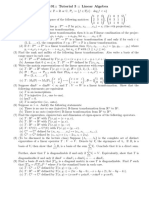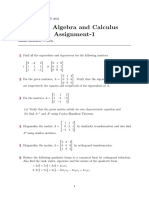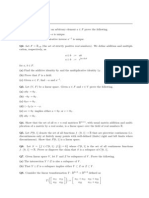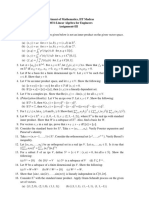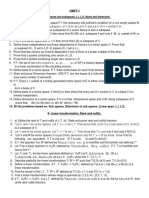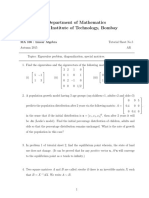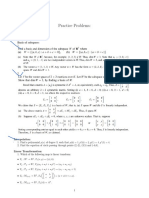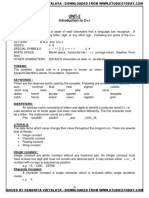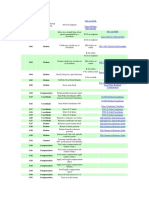MTL101:: Tutorial-3:: Linear Algebra
Notation: F = R or C, Pn := {f ∈ F [x] : degf < n}
(1) Find a basis of the row space of the following matrices:
t
1 2 3 1 0 2 5
2 3 4 , 0 3 1 1 .
3 4 5 3 1 0 1
(2) For i ∈ {1, 2, . . . , n}, define pi : Fn → F by pi (x1 , x2 . . . , xn ) = xi (the
i-th projection).
(a) Show that it is a linear transformation.
(b) If T : Fn → F is a linear transformation then it is an F -linear
combination of the projections, that is, T = a1 p1 + a2 p2 . . . + an pn
for a1 , . . . an ∈ F.
(c) Further, show that S : Fm → Fn is a linear transformation if and
only if for each i ∈ {1, 2, . . . n}, the composition pi ◦ S : Fm → F
is a linear transformation.
(d) If S : Fm → Fn is a linear transformation then S(x1 , x2 , . . . xm )
= (y1 , y2 , . . . yn ) where yi = ai1 x1 + ai2 x2 + . . . + aim xm for aij ∈ F
with (1 ≤ i ≤ n, 1 ≤ j ≤ m).
(3) Find the rank and nullity of the following linear transformations. Also
write a basis of the range space in each case.
(a) T : F3 → F3 defined by T (x, y, z) = (x + y + z, x − y + z, x + z).
(b) Assume that 0 ≤ m ≤ n. T : Fn → Fm defined by T (x1 , x2 , . . . , xn ) =
(x1 , x2 , . . . , xn ).
(4) Write the matrix representations of the linear operators with respect
to the ordered basis B.
(a) T : R2 → R2 where T (x, y) = (x, y), B = {(1, 1), (1, −1)}
(b) D : Pn+1 → Pn+1 such that D(a0 + a1 x + . . . + an xn )
= a1 + 2a2 x + . . . + nan xn−1 , B = {1, x, . . . , xn }.
1
� �
� � �
x y x+w z
(c) T : M2 (F) → M2 (F), T = ,
� � � z
� � w � � z + w � x
1 0 0 1 0 0 0 0
B={ , , , }
0 0 0 0 1 0 0 1
(5) Suppose dimV = dimW < 1 and T : V → W is a linear transforma-
tion. Show that the following statements are equivalent
(i) T is an isomorphism.
(ii) T is injective (i.e., one to one).
(iii) kerT = 0.
(iv) T is surjective (i.e., onto).
(6) Suppose m > n. Justify the following statements:
(a) There is no one to one (injective) R-linear transformation from
Rm to Rn .
(b) There is no onto (surjective) R-linear tranformation from Rn to
Rm .
(7) Find the eigenvalues, eigenvectors and dimension of eigen-spaces of the
following operators.
(a) T : R2 → R2 with T (x; y) = (x + y, x),
(b) T : R2 → R2 with T (x; y) = (y, x),
(c) T : R2 → R2 with T (x; y) = (y, −x)
(d) T : C2 (C) → C2 (C) with T (x; y) = (y, −x).
(e) T : Cn → Cn with T (x1 , x2 , . . . , xn ) = (xn , x1 , . . . , xn−1 ).
(f) T : C2 → C2 with T (z1 , z2 ) = (z1 − 2z2 , z1 + 2z2 ).
(8) Find a basis B such that [T ]B is a diagonal matrix in case T is diago-
nalizable. Find P such that [T ]B = P [T ]S P −1 where S is the standard
basis in each case.
(a) T : C2 → C2 defined by T (x, y) = (y, −x).
(b) T : C3 → C3 defined by T (x, y, z) = (5x − 6y − 6z, −x + 4y +
2z, 3x − 6y − 4z).
2
� (c) T : C2 → C2 defined by T (x, y) = (xcosθ+ysinθ, −xsinθ+ycosθ).
(9) Characteristic polynomial of a matrix is satisfied by the matrix(Cayley
Hamilton). Use it to find(invertibility and) the inverse of the following
operators.
(a) (x, y, z) → (x + y + z, x + z, −x + y).
(b) (x, y, z) → (x, x + 2y, x + 2y + 3z).
(10) Which of the following is an inner product.
(a) h(x1 , y1 ), (x2 , y2 )i = x1 x2 + y1 y2 + 3 on R2 over R.
(b) h(x1 , y1 ), (x2 , y2 )i = x1 x2 − y1 y2 on R2 over R.
(c) h(x1 , y1 ), (x2 , y2 )i = y1 (x1 + 2x2 ) + y2 (2x1 + 5x2 ) on R2 over R.
(d) h(x1 , y1 ), (x2 , y2 )i = x1 x2 + y1 y2 on C2 over C.
(e) h(x1 , y1 ), (x2 , y2 )i = x1 x¯2 − y1 y¯2 on C2 over C.
(f) If A, B ∈ Mn (C) define hA, Bi = T race(AB̄).
(g) Suppose C[0, 1] is the space of continuous complex valued R 1 func-
tions on the interval [0, 1] and for f, g ∈ C[0, 1], hf, gi := 0 f (t)g(t) dt.
� �
a b
(11) Suppose A = ∈ M2 (R) is such that a > 0 and det(A) =
c d
ad − b2 > 0. Show that hX, Y i = X t AY is an inner product on R2 .
p
(12) Suppose V is an inner product space. Define kvk = hv, vi. Show the
following statements.
(a) kvk = 0 if and only if v = 0.
(b) For a ∈ F, kavk = |a|kvk.
(c) ku + vk ≤kuk+kvk.
(d) |kvk − kwk| ≤ kv − wk.
(e) hu, vi = 0 then ku + vk2 = kuk2 + kvk2 .
(13) Use standard inner product on R2 over R to prove the following state-
ment: ”A parallelogram is a rhombus if and only if its diagonals are
perpendicular to each other.”
3
�(14) Find with respect to the standard inner product of R3 , an orthonormal
basis containing (1, 1, 1).
(15) Find an orthonormal basis of Pn = {f (x) ∈ R[x] R: deg f (x) < 3} with
1
respect to the inner product defined by hf, gi := 0 f (t)g(t) dt.
(16) Suppose W is a subspace of the finite dimensional inner product space.
Define W ⊥ := {v ∈ V : hw, vi = 0 for all w ∈ W }. Show the following
statements.
(a) W ⊥ is a subspace of V.
(b) W ∩ W ⊥ = 0.
L ⊥
(c) V = W W .
(d) (W ⊥ )⊥ = W .
(17) Suppose W = {(x, y) ∈ R2 : x + y = 0}. Find the shortest distance of
(a, b) ∈ R2 from W with respect to (i) the standard inner product, (ii)
the inner product defined by h(x1 , y1 ), (x2 , y2 )i = 2x1 x2 + y1 y2 .
